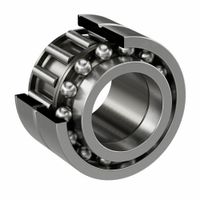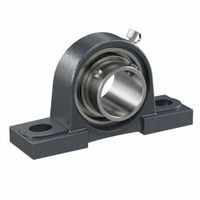Call +(254) 703 030 000 / 751 483 999 / 721 704 777
- Home
- Power Transmission
- Bearings
- Rolling Element Bearings
.....Read More
Frequently Asked Questions
What are the different types of rolling-element bearings?
Rolling-element bearings are mechanical components used to reduce friction between moving parts and support radial and axial loads. The main types include:
1. **Ball Bearings**: Utilize spherical balls to maintain separation between bearing races. They are versatile, handling both radial and axial loads, and are used in applications like electric motors and hard drives.
2. **Roller Bearings**: Use cylindrical rollers instead of balls, providing a larger contact area and higher load capacity. They are ideal for heavy radial loads. Types include:
- **Cylindrical Roller Bearings**: Handle high radial loads and moderate speeds.
- **Spherical Roller Bearings**: Accommodate misalignment and support heavy radial and axial loads.
- **Tapered Roller Bearings**: Designed to handle large radial and axial loads, often used in automotive applications.
- **Needle Roller Bearings**: Feature long, thin rollers, suitable for applications with limited radial space.
3. **Thrust Bearings**: Specifically designed to handle axial loads. Types include:
- **Ball Thrust Bearings**: Handle low axial loads and are used in low-speed applications.
- **Roller Thrust Bearings**: Support higher axial loads and are used in automotive and industrial machinery.
4. **Self-aligning Bearings**: Have two rows of balls or rollers and a common spherical raceway in the outer ring, allowing for misalignment of the shaft.
5. **Precision Bearings**: Designed for high-speed and high-precision applications, such as aerospace and medical equipment.
Each type of rolling-element bearing is selected based on load capacity, speed, alignment, and application-specific requirements.
How do ball bearings differ from roller bearings?
Ball bearings and roller bearings are both types of rolling-element bearings used to reduce friction and support radial and axial loads in machinery. However, they differ in design, load capacity, and applications.
Ball bearings use spherical balls as the rolling elements. These balls are housed between two races, an inner and an outer race. The point contact between the balls and the races allows for smooth rotation and can handle both radial and axial loads. Ball bearings are ideal for applications requiring low friction, high-speed operation, and moderate load capacity. They are commonly used in applications like electric motors, fans, and hard drives.
Roller bearings, on the other hand, use cylindrical, tapered, or needle-shaped rollers as the rolling elements. The line contact between the rollers and the races allows roller bearings to support higher radial loads compared to ball bearings. Depending on the design, some roller bearings can also handle axial loads. Types of roller bearings include cylindrical roller bearings, tapered roller bearings, and needle roller bearings. These bearings are suitable for heavy-duty applications such as conveyor belt rollers, gearboxes, and heavy machinery.
In summary, the primary difference lies in the shape of the rolling elements and the type of contact they make with the races. Ball bearings are better suited for high-speed, low-load applications, while roller bearings are designed for higher load capacities and can accommodate more significant misalignments. The choice between the two depends on the specific requirements of the application, including load, speed, and alignment considerations.
What are the advantages of using rolling-element bearings?
Rolling-element bearings offer several advantages:
1. **Low Friction**: They significantly reduce friction between moving parts, leading to smoother operation and less energy loss.
2. **High Load Capacity**: These bearings can support both radial and axial loads, making them versatile for various applications.
3. **Durability and Longevity**: Made from high-quality materials, they are designed to withstand wear and tear, providing a long service life.
4. **Precision and Accuracy**: They maintain precise alignment of components, which is crucial in applications requiring high accuracy.
5. **Reduced Maintenance**: With proper lubrication, rolling-element bearings require minimal maintenance, reducing downtime and operational costs.
6. **Versatility**: Available in various designs and sizes, they can be used in a wide range of industries, from automotive to aerospace.
7. **High-Speed Capability**: They can operate at high speeds with minimal heat generation, making them suitable for high-speed applications.
8. **Compact Design**: Their compact size allows for efficient use of space in machinery and equipment.
9. **Ease of Replacement**: Standardized sizes and designs make it easy to replace or upgrade bearings without extensive modifications.
10. **Noise Reduction**: They help in reducing noise and vibration in machinery, contributing to a quieter operation.
11. **Cost-Effectiveness**: Despite the initial cost, their long lifespan and efficiency lead to cost savings over time.
12. **Temperature Tolerance**: They can operate effectively in a wide range of temperatures, suitable for various environmental conditions.
These advantages make rolling-element bearings a preferred choice in many mechanical systems, enhancing performance and reliability.
How do you select the right bearing for an application?
Selecting the right bearing for an application involves several key considerations:
1. **Load Type and Magnitude**: Determine whether the load is radial, axial, or a combination. Choose bearings like deep groove ball bearings for radial loads, or thrust bearings for axial loads. Consider the load magnitude to ensure the bearing can handle the stress.
2. **Speed Requirements**: Assess the operational speed. High-speed applications may require precision bearings with low friction, such as ceramic or hybrid bearings.
3. **Operating Environment**: Consider temperature, humidity, and exposure to contaminants. For high temperatures, select bearings with appropriate heat-resistant materials. For corrosive environments, stainless steel or coated bearings may be necessary.
4. **Life Expectancy and Reliability**: Calculate the bearing life using the L10 life formula, considering the load and speed. Choose a bearing with a life expectancy that meets or exceeds the application's requirements.
5. **Space Constraints**: Evaluate the available space for the bearing. Compact applications may require thin-section or miniature bearings.
6. **Mounting and Alignment**: Consider the ease of installation and alignment. Self-aligning bearings can compensate for misalignment, while split bearings simplify installation in tight spaces.
7. **Lubrication Needs**: Determine the lubrication method, whether grease or oil, and ensure compatibility with the bearing material and operating conditions.
8. **Cost and Availability**: Balance performance requirements with budget constraints. Consider the availability of the bearing type and size for maintenance and replacement.
9. **Regulatory and Industry Standards**: Ensure compliance with relevant standards and certifications for the application, such as ISO or ANSI.
10. **Supplier Support and Service**: Choose a reputable supplier that offers technical support, customization options, and after-sales service.
By carefully evaluating these factors, you can select a bearing that optimally meets the application's demands.
What are common causes of bearing failure?
Common causes of bearing failure include:
1. **Lubrication Issues**: Inadequate lubrication, using the wrong type of lubricant, or contamination of the lubricant can lead to increased friction and wear, causing premature bearing failure.
2. **Contamination**: Dirt, dust, and other foreign particles can enter the bearing, leading to surface damage and increased wear. Contaminants can also mix with the lubricant, reducing its effectiveness.
3. **Misalignment**: Improper alignment of the bearing with the shaft or housing can cause uneven load distribution, leading to excessive stress and wear on the bearing components.
4. **Overloading**: Bearings are designed to handle specific load capacities. Exceeding these limits can cause deformation, increased friction, and eventual failure.
5. **Improper Installation**: Incorrect installation techniques, such as using excessive force or not following manufacturer guidelines, can damage the bearing or lead to misalignment.
6. **Corrosion**: Exposure to moisture or corrosive environments can lead to rust and pitting on the bearing surfaces, weakening the structure and leading to failure.
7. **Fatigue**: Repeated stress cycles can cause material fatigue, leading to the formation of cracks and eventual spalling of the bearing surfaces.
8. **Electrical Erosion**: Electrical currents passing through the bearing can cause pitting and fluting, leading to surface damage and increased wear.
9. **Vibration**: Excessive vibration can lead to fretting and wear, especially if the bearing is not properly secured or if there is an imbalance in the rotating components.
10. **Improper Handling and Storage**: Dropping or mishandling bearings during transport or storage can cause physical damage, while improper storage conditions can lead to corrosion or contamination.
How do you maintain and lubricate rolling-element bearings?
To maintain and lubricate rolling-element bearings effectively, follow these steps:
1. **Regular Inspection**: Periodically check bearings for signs of wear, noise, or vibration. Look for discoloration, scoring, or pitting on the bearing surfaces.
2. **Proper Cleaning**: Clean bearings using a suitable solvent to remove old grease, dirt, and debris. Ensure the bearing is completely dry before re-lubrication.
3. **Correct Lubricant Selection**: Choose the appropriate lubricant based on the bearing type, operating conditions, and manufacturer recommendations. Common lubricants include grease and oil, with grease being more common for rolling-element bearings.
4. **Lubrication Method**:
- **Grease**: Apply the correct amount of grease, typically filling 30-50% of the bearing's free space. Over-greasing can cause overheating, while under-greasing can lead to increased friction and wear.
- **Oil**: Use oil baths, oil mist, or circulating oil systems for lubrication. Ensure the oil level is maintained and replace it at recommended intervals.
5. **Temperature Monitoring**: Keep an eye on operating temperatures. Excessive heat can degrade lubricants and damage bearings. Use temperature sensors if necessary.
6. **Contamination Control**: Protect bearings from contaminants by using seals, shields, or covers. Ensure the working environment is clean and free from dust, moisture, and chemicals.
7. **Alignment and Mounting**: Ensure proper alignment and mounting of bearings to prevent uneven load distribution. Use appropriate tools and techniques for installation and removal.
8. **Load and Speed Management**: Operate bearings within their specified load and speed limits to prevent premature failure.
9. **Documentation and Scheduling**: Maintain records of maintenance activities and establish a regular lubrication schedule based on operating conditions and manufacturer guidelines.
By following these practices, you can extend the life of rolling-element bearings and ensure reliable operation.
What are the signs of a failing bearing?
Signs of a failing bearing include:
1. **Unusual Noises**: Grinding, squealing, or knocking sounds often indicate wear or damage. These noises result from metal-to-metal contact or debris within the bearing.
2. **Excessive Vibration**: Increased vibration can signal misalignment, imbalance, or wear. Bearings in good condition should operate smoothly with minimal vibration.
3. **Increased Temperature**: Overheating is a common sign of bearing failure. It can be caused by excessive friction due to inadequate lubrication or excessive load.
4. **Lubricant Issues**: Contaminated or insufficient lubricant can lead to increased friction and wear. Check for changes in lubricant color, consistency, or presence of metal particles.
5. **Visible Damage**: Inspect for cracks, corrosion, or wear on the bearing surface. Physical damage often indicates advanced failure.
6. **Increased Friction**: A failing bearing may cause increased resistance, leading to higher energy consumption and reduced efficiency.
7. **Shaft Movement**: Excessive play or movement in the shaft can indicate bearing wear or misalignment.
8. **Unusual Smells**: Burning or unusual odors can result from overheating or lubricant breakdown.
9. **Reduced Performance**: Decreased machine performance or efficiency can be a subtle sign of bearing issues.
10. **Frequent Maintenance**: If a bearing requires frequent adjustments or replacements, it may be failing.
11. **Misalignment**: Misaligned bearings can cause uneven wear and premature failure.
12. **Load Issues**: Bearings subjected to excessive or uneven loads may fail prematurely.
Regular monitoring and maintenance can help detect these signs early, preventing catastrophic failure and extending the bearing's lifespan.




